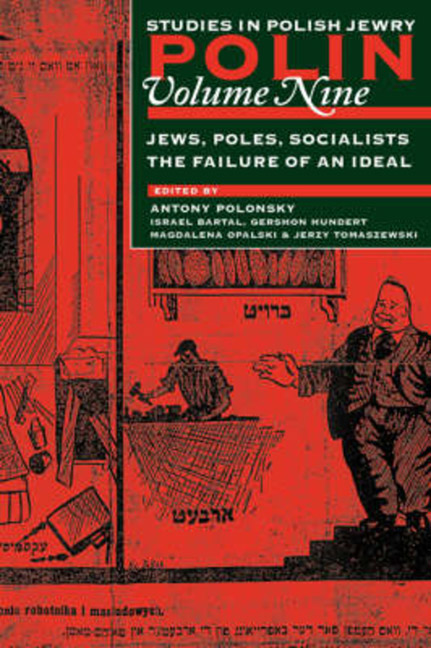Book contents
- Frontmatter
- Dedication
- Editors and Advisers
- Preface
- Acknowledgement
- Polin
- Polin: Studies in Polish Jewry
- Contents
- Note on Transliteration, Names, and Place Names
- Abbreviations
- Introduction
- PART I POLES, JEWS, SOCIALISTS: THE FAILURE OF AN IDEAL
- Jewish Socialists in the Kingdom of Poland
- The Jewish Problem in Polish Socialist Thought
- The Relation of the Polish Socialist Party: Proletariat to the Bund and the Jewish Question, 1900-1906
- The Jews, the Left, and the State Duma Elections in Warsaw in 1912: Selected Sources
- Jews and the Russian Revolution: A Note
- The Bund in Poland, 1935-1939
- Łodź Remained Red: Elections to the City Council of 27 September 1936
- The Jews of Vilna under Soviet Rule, 19 September-28 October 1939
- The Polish Underground and the Extermination of the Jews
- The Jewish Underground and the Polish Underground
- The Pogrom in Kieke on 4July 1946
- Antisemitism in Poland in 1956
- PART II NEW VIEWS
- PART III REVIEWS
- REVIEW ESSAYS
- BOOK REVIEWS
- Bibliography Of Polish-Jewish Studies, 1993
- Notes on Contributors
- Notes on Translators
- Glossary
- Index
The Pogrom in Kieke on 4July 1946
from PART I - POLES, JEWS, SOCIALISTS: THE FAILURE OF AN IDEAL
- Frontmatter
- Dedication
- Editors and Advisers
- Preface
- Acknowledgement
- Polin
- Polin: Studies in Polish Jewry
- Contents
- Note on Transliteration, Names, and Place Names
- Abbreviations
- Introduction
- PART I POLES, JEWS, SOCIALISTS: THE FAILURE OF AN IDEAL
- Jewish Socialists in the Kingdom of Poland
- The Jewish Problem in Polish Socialist Thought
- The Relation of the Polish Socialist Party: Proletariat to the Bund and the Jewish Question, 1900-1906
- The Jews, the Left, and the State Duma Elections in Warsaw in 1912: Selected Sources
- Jews and the Russian Revolution: A Note
- The Bund in Poland, 1935-1939
- Łodź Remained Red: Elections to the City Council of 27 September 1936
- The Jews of Vilna under Soviet Rule, 19 September-28 October 1939
- The Polish Underground and the Extermination of the Jews
- The Jewish Underground and the Polish Underground
- The Pogrom in Kieke on 4July 1946
- Antisemitism in Poland in 1956
- PART II NEW VIEWS
- PART III REVIEWS
- REVIEW ESSAYS
- BOOK REVIEWS
- Bibliography Of Polish-Jewish Studies, 1993
- Notes on Contributors
- Notes on Translators
- Glossary
- Index
Summary
ON 4 July 1946 there was a pogrom against the Jews in Kieke. This tragedy was especially poignant in that those who were murdered had just survived the Holocaust, and that there had been a long history of relatively good relations between the Polish and Jewish populations in the city.
The history of Jewish settlement in Kieke begins relatively late: they arrived only after the Tsar's emancipation decree of 24 June-5 July l 862, which removed the earlier prohibitions on Jews settling there. Because Kieke had been a bishop's seat, Jews had been forbidden to reside there on a permanent basis. They could, however, engage in activities on market days and during fairs. Moreover, the restrictions against settlement were not strictly enforced: in 1841 six Jewish families, amounting to thirty-two individuals, were recorded among the inhabitants.
The decree removing restrictions did not immediately alter ingrained habits: at first local Jews preferred to continue to live in nearby Chęciny and commute to Kieke. The Jewish influx began only after 1866, and twenty years later Jews constituted 28 per cent of the city's inhabitants. One visible sign of Jewish economic and social advancement was the synagogue erected in 1902.
With the defeat of those favouring a partitioned Poland and the return of Polish independence, Jews constituted a third of the population of Kieke. Data from the 1921 general census show that out of the city's 41,346 inhabitants, 15,530 were Jews (37.6 per cent). At the time of the next census in 1931 Jews made up 31.05 per cent of the population. Their traditional occupations were crafts, especially leather and clothing, and trade. There was significant variety in the material status of Jews: a few were owners of large industrial or trade enterprises, while some made their living from occasional jobs, independent contracting, or as small shopkeepers or owners of stalls. In 1938 six of the twelve owners of factories with the largest turnover and profit were Jews; but most firms were small, with little capital and low profits. Small traders were especially well represented: in 1926 as many as 2,100 permanent places of trade existed in Kieke, (60 per cent in Jewish ownership). There were fifty-five restaurants and eatinghouses, and one greengrocer for every fifty-two inhabitants. Such scattered trade had a weak economic base and provided the majority of tradespeople with only a poor livelihood.
- Type
- Chapter
- Information
- Jews, Poles, Socialists: The Failure of an Ideal , pp. 158 - 169Publisher: Liverpool University PressPrint publication year: 2008

